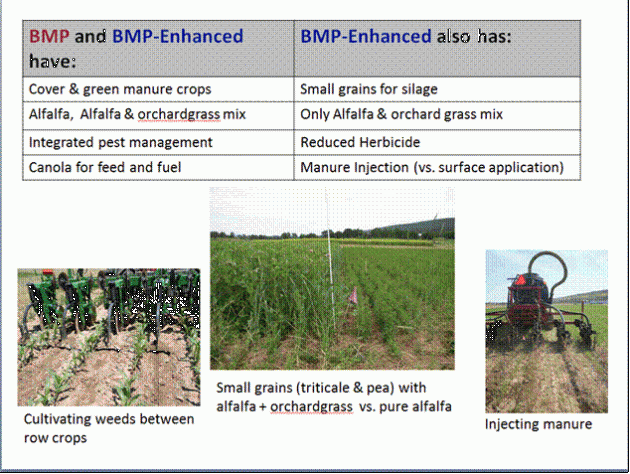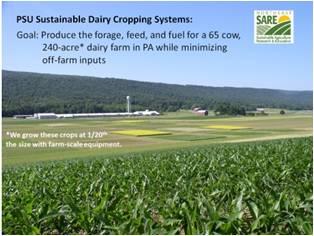![]() Waste to Worth home | More proceedings….
Waste to Worth home | More proceedings….
Abstract
An interdisciplinary team of Penn State and USDA-ARS researchers are evaluating a Sustainable Cropping System to test the hypothesis that a dairy farm can minimize off-farm inputs and environmental impacts, and be productive, profitable and sustainable. Established in 2010 at the Penn State Agronomy Research Farm, the farm produces grain, forage and tractor fuel at 1/20th the scale of an average sized Pennsylvania dairy of 240 acres. The farm includes two diverse 6-yr crop rotations that include manure injection, perennial legumes, cover and green manure crops; a cover crop roller, winter canola, and a straight vegetable oil tractor. Within each crop rotation two management practices for no-till crop production are compared:
1. Forage Rotation compares injected manure (IM) to broadcast manure (BM); and
2. Grain Rotation compares a combination of weed management strategies designed to reduce herbicide (RH) use relative to a “standard” herbicide (SH) weed management program.
The two diverse cropping systems are designed to provide all the forage and feed for 65 lactating cows housed in a tie-stall barn, 10 dry cows and 75 young-stock. Crops are analyzed for crude protein, neutral detergent fiber, and net energy of lactation; the production of a “virtual dairy herd” is simulated using the 2001 NRC dairy nutrition model. Performance of the two farm scenarios (BMSH or IMRH) is compared. Income-over-feed costs are monitored monthly to evaluate impact of forage quality and quantity on profitability. The economic performance of the two cropping systems: BMSH vs. IMRH will be highlighted. In 2010, the IMRH scenario had a slight trend of higher income over feed cost compared to the BMSH scenario. Related: Manure value & economics
Why Is a ‘Systems’ Approach Important for Dairies?
New agronomic management practices and technologies are often evaluated in one or two specific crops for a few growing seasons. Management practices on farms however are integrated into crop rotations, where a combination of practices can have cumulative effects on multiple aspects of the agroecosystem. This project takes an interdisciplinary approach to develop sustainable dairy cropping systems and monitor multiple indicators of systems performance. Utilizing ecological principles and innovative practices, we designed two six-year dairy crop rotations to minimize off-farm inputs and environmental impacts for a typical-sized Pennsylvania dairy farm. Within each rotation we have been comparing innovative manure or weed management strategies, as well as evaluating two green manure crops, and a tactic to sustain mycorrhizae populations in canola. The two crop rotations also compare two approaches to integrating winter canola into a dairy crop rotation.
What Did We Do?
Two cropping systems were developed to compare diverse strategies that include canola in a dairy farm rotation. The two rotations consist of 12 crop entries, each main plot being 90’ x 121’with split plots of 45’ x 121’.
|
Agronomy farm at Penn State University where the cropping systems are being evaluated. |
The splits within the two cropping system rotations are:
Forage rotation: Corn silage/winter wheat underseeded red clover – Corn silage – canola – alfalfa (3 yr)Split plots in the forage rotation compare the use of manure shallow disk injection versus surface-applied, broadcast manure.
Grain rotation: Alfalfa (2 yr)-Canola – Rye –Soybeans/Rye -Corn grain
To reduce herbicide use, split plots evaluate a combination of mechanical and cultural weed control practices used to reduce herbicides use (banding herbicides over the crop row, inter-row cultivation, companion cropping annual with alfalfa, and one plowing event).
What Have We Learned?
By assessing the performance of the innovative practices and the dairy cropping systems from a multidisciplinary perspective, over the past three years we have gained an understanding of their performance, as well as agroecosystem interactions, benefits, and trade-offs. Overall the cropping systems and the majority of the innovative practices are providing multiple agroecosystem benefits, although a few practices need to be modified to improve their performance.
In the first three years, both of the sustainable dairy cropping systems (inject manure and reduced herbicide (IMRH) and broadcast manure and standard herbicide (BMSH)) produced almost all of the virtual dairy herd’s feeds and forage, and all of the farm’s tractor fuel needs along with some additional canola oil to sell. The economics of the virtual farm show the purchased feed costs per cow are about half of what they would be on a “typical” dairy operation.
The assumptions made for the virtual dairy farm is that it is a start-up herd with the land and buildings in place. Loans were taken out to purchase animals and to remodel the facilities. This explains why the breakeven income over feed costs is high compared to what is observed on established dairy farms in Pennsylvania. When summarizing the cash flow plans for both scenarios, the IMRH has been trending with more income per cow compared to the BMSH. Even with the high breakeven income over feed costs, the BMSH has averaged about $1.00 and IMRH about $1.85 above breakeven for 2011-2012 on average.
 |
 |
Future Plans
We are still simulating and analyzing the virtual dairy herd production and economic performance and plan to conduct additional advanced economic analyses over the next three years. We will continue to monitor the cropping systems, learn how to improve their performance, and share this information through scientific literature and outreach educational activities and materials.
Authors
Virginia Ishler, Dairy Complex Manager and Nutrient Management Specialist, Penn State University, vishler@psu.edu
Heather Karsten, Associate Professor of Crop Production/Ecology, Penn State University
Glenna Malcolm, Post Doctoral Researcher, Penn State University
Tim Beck, Extension Educator, Penn State University
Additional Information
Detailed information about this project as well as publications and other resources can be found at http://plantscience.psu.edu/research/areas/crop-ecology-and-management/cropping-systems
A link to our 2012 Project summary report on the NESARE website. https://projects.sare.org/sare_project/lne09-291/
Acknowledgements
Funding has been provided NESARE (Northeast Sustainable Agriculture Research and Extension) and collaboration with USDA-ARS.
The authors are solely responsible for the content of these proceedings. The technical information does not necessarily reflect the official position of the sponsoring agencies or institutions represented by planning committee members, and inclusion and distribution herein does not constitute an endorsement of views expressed by the same. Printed materials included herein are not refereed publications. Citations should appear as follows. EXAMPLE: Authors. 2013. Title of presentation. Waste to Worth: Spreading Science and Solutions. Denver, CO. April 1-5, 2013. URL of this page. Accessed on: today’s date.


